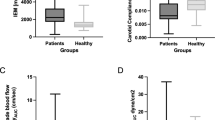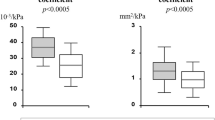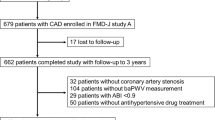Abstract
Increased carotid stiffness and impaired brachial artery flow-mediated dilatation (FMD) associate with cardiovascular events. We have previously reported three FMD patterns based on the time of maximal dilatation. The aim of the present study was to verify whether different FMD patterns associate with carotid artery stiffness. In all, 133 subjects were enrolled. All participants underwent complete clinical examination, blood sampling and ultrasound study. FMD was used as a measure of endothelial function. Based on the maximal brachial artery FMD, subjects were divided into Early dilators (peak FMD at 50 s), Late dilators (peak FMD over 50 s) and No dilators. Echo-Doppler evaluation of carotid arteries was performed in order to calculate elastic indexes (strain, β-stiffness index and distensibility). In all, 64 subjects were classified as Early FMD, 36 as Late FMD and 33 as No dilators. Age, gender and cardiovascular risk factors were comparable among three groups. Early FMD had higher values of strain compared with both Late and no Dilators (P<0.001). Furthermore, Early dilators showed a significantly lower stiffness and higher distensibility compared with Late and No dilators. No significant differences between Late FMD and No Dilators were detected. Our results demonstrate that common carotid artery elasticity indexes significantly differ among Early, Late and No dilators. Subjects with delayed or absent brachial artery dilatation have stiffer common carotid arteries compared with subjects with early dilatation. In conclusion, our research suggests that the assessment of the kinetics of FMD in a clinical setting might represent a useful screening tool to improve the cardiovascular risk stratification.
This is a preview of subscription content, access via your institution
Access options
Subscribe to this journal
Receive 12 digital issues and online access to articles
$119.00 per year
only $9.92 per issue
Buy this article
- Purchase on Springer Link
- Instant access to full article PDF
Prices may be subject to local taxes which are calculated during checkout

Similar content being viewed by others
References
Ross R . The pathogenesis of atherosclerosis: a perspective for the 1990s. Nature 1993; 362: 801–809.
Okimoto H, Ishigaki Y, Koiwa Y, Hinokio Y, Ogihara T, Suzuki S et al. A novel method for evaluating human carotid artery elasticity: possible detection of early stage atherosclerosis in subjects with type 2 diabetes. Atherosclerosis 2008; 196: 391–397.
Cecelja M, Chowienczyk P . Role of arterial stiffness in cardiovascular disease. JRSM Cardiovasc Dis 2012; 1: 11.
Cohn JN . Arterial stiffness, vascular disease, and risk of cardiovascular events. Circulation 2006; 113: 601–603.
Mancia G, Fagard R, Narkiewicz K, Redán J, Zanchetti A, Böhm M et alList of authors Task Force members. 2013 Practice guidelines for the management of arterial hypertension of the European Society of Hypertension (ESH) and the European Society of Cardiology (ESC): ESH/ESC Task Force for the Management of Arterial Hypertension. J Hypertens 2013; 31: 1925–1938.
Ratchford EV, Gutierrez J, Lorenzo D, McClendon MS, Della-Morte D, DeRosa JT et al. Short-term effect of atorvastatin on carotid artery elasticity: a pilot study. Stroke 2011; 42: 3460–3464.
Godia EC, Madhok R, Pittman J, Trocio S, Ramas R, Cabral D et al. Carotid artery distensibility: a reliability study. J Ultrasound Med 2007; 26: 1157–1165.
Blaha MJ, Budoff MJ, Rivera JJ, Katz R, O'Leary DH, Polak JF et al. Relationship of carotid distensibility and thoracic aorta calcification: multi-ethnic study of atherosclerosis. Hypertension 2009; 54: 1408–1415.
Myung Y, Seo HS, Jung IH, Lee NH, Suh J, Choi JH et al. The correlation of carotid artery stiffness with heart function in hypertensive patients. J Cardiovasc Ultrasound 2012; 20: 134–139.
Tsivgoulis G, Vemmos K, Papamichael C, Spengos K, Daffertshofer M, Cimboneriu A et al. Common carotid arterial stiffness and the risk of ischaemic stroke. Eur J Neurol 2006; 13: 475–481.
Simons PCG, Algra A, Bots ML, Grobbee DE, van der Graaf Y . Common carotid intima-mediathickness and arterial stiffness: indicators of cardiovascular risk in high-risk patients. The SMART Study (Second Manifestations of Arterial Disease). Circulation 1999; 100: 951–957.
Yang EY, Chambless L, Sharrett AR, Virani SS, Liu X, Tang Z et al. Carotid arterial wall characteristics are associated with incident ischemic stroke but not coronary heart disease in the Atherosclerosis Risk in Communities (ARIC) study. Stroke 2012; 43: 103–108.
Celermajer DS, Sorensen KE, Gooch VM, Spiegelhalter DJ, Miller OI, Sullivan ID et al. Non-invasive detection of endothelial dysfunction in children and adults at risk of atherosclerosis. Lancet 1992; 340: 1111–1115.
Irace C, Tschakovsky ME, Carallo C, Cortese C, Gnasso A . Endothelial dysfunction or dysfunctions? Identification of three different FMD responses in males with type 2 diabetes. Atherosclerosis 2008; 200: 439–445.
Irace C, Carallo C, Loprete A, Tripolino C, Scavelli F, Gnasso A . Delayed flow-mediated vasodilation and carotid atherosclerosis. Eur J Clin Invest 2013; 43: 49–55.
Irace C, Padilla J, Carallo C, Scavelli F, Gnasso A . Delayed vasodilation is associated with cardiovascular risk. Eur J Clin Invest 2014; 44: 549–556.
Irace C, Tripolino C, Scavelli F, Messiniti V, Tassone B, Della Valle E et al. Blood viscosity but not shear stress associates with delayed flow-mediated dilation. Eur J Appl Physiol 2015; 115: 747–753.
Tinken TM, Thijssen DH, Black MA, Cable NT, Green DJ . Time course of change in vasodilator function and capacity in response to exercise training in humans. J Physiol 2008; 586: 5003–5012.
Wang TJ . Assessing the role of circulating, genetic, and imaging biomarkers in cardiovascular risk prediction. Circulation 2011; 123: 551–565.
Cohn JN, Duprez DA, Grandits GA . Arterial elasticity as part of a comprehensive assessment of cardiovascular risk and drug treatment. Hypertension 2005; 46: 217–220.
Yeboah J, Folsom AR, Burke GL, Johnson C, Polak JF, Post W et al. Predictive value of brachial flow-mediated dilation for incident cardiovascular events in a population-based study: the multi-ethnic study of atherosclerosis. Circulation 2009; 120: 502–509.
Kobayashi K, Akishita M, Yu W, Hashimoto M, Ohni M, Toba K . Interrelationship between non-invasive measurements of atherosclerosis: flow-mediated dilation of brachial artery, carotid intima-media thickness and pulse wave velocity. Atherosclerosis 2004; 173: 13–18.
Lunder M, Janic M, Kejzar N, Sabovic M . Associations among different functional and structural arterial wall properties and their relations to traditional cardiovascular risk factors in healthy subjects: a cross-sectional study. BMC Cardiovasc Disord 2012; 12: 29.
Horvath T, Pinter A, Kollai M . Carotid artery stiffness is not related to endothelial function in young healthy subjects. Auton Neurosci 2012; 166: 85–88.
Liuni A, Luca MC, Lisi M, Dragoni S, di Stolfo G, Mariani JA et al. Observations of time-based measures of flow-mediated dilation of forearm conduit arteries: implications for the accurate assessment of endothelial function. Am J Physiol Heart Circ Physiol 2010; 299: H939–H945.
Palinkas A, Toth E, Venneri L, Rigo F, Csanady M, Picano E . Temporal heterogeneity of endothelium-dependent and –independent dilatation of brachial artery in patients with coronary artery disease. Int J Cardiovasc Imaging 2002; 18: 337–342.
Acknowledgements
No external funding, apart from the support of the authors’ institution, was available for this study.
Author information
Authors and Affiliations
Corresponding author
Ethics declarations
Competing interests
The authors declare no conflict of interest.
Rights and permissions
About this article
Cite this article
Tripolino, C., Gnasso, A., Carallo, C. et al. Difference in carotid artery elasticity in subjects with different brachial artery kinetic of vasodilatation. J Hum Hypertens 30, 493–497 (2016). https://doi.org/10.1038/jhh.2015.109
Received:
Revised:
Accepted:
Published:
Issue Date:
DOI: https://doi.org/10.1038/jhh.2015.109



